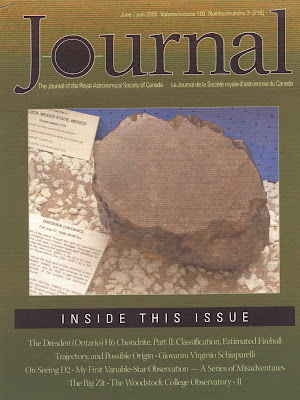Recently in the news is the appearance of a comet called C/2022 E3 (ZTF). It was discovered last March by astronomers and apparently only comes around every 50,000 years. Last night it made its closest appearance to earth. It could be seen not far from Polaris (the north star) in the constellation Camelopardalis.
I managed to find it after some effort, but it was a disappointment. The moon was too bright and without going out of town to avoid light pollution, it was barely visible with binoculars.
Comets appear all the time, but many are not visible with the naked eye. Whenever one comes around that is visible, I make an attempt to see it.
There are some good photos of this recent comet which you can search out for yourself on the internet.
I have always been interested in astronomy and things visible in the night sky. Quite a few years ago I wrote about a fireball that came down in Kent County in 1939. It was dubbed the Dresden meteorite. However, it was not really anywhere near Dresden, but closer to Oungah! The following link shows the location: Dresden Meteorite
A few years ago, a 3-D replica was made of this rock. Here is the link to that information: 3d-printed-replica-of-dresden-meteorite-western-university-department-of-physics-and-astronomy
Below is what I wrote several years ago:
A while back, I read about a meteorite that came to earth southwest of Dresden. A large fireball fell out of the sky on the night of July 11, 1939 and was seen for hundreds of miles. Several pieces were scattered about, but the main mass buried itself into the ground on the Solomon farm along Cedar Hedge Line east of Prince Albert Road.
Meteorites come to earth all the time, but most are quite minute and disintegrate by the time they reach the lower reaches of the earth’s atmosphere. On rare occasions, sizable chunks will hit the earth, and these are highly sought after by collectors and scientists.
The rock that came down in 1939 in Chatham-Kent was in fact quite large. Several pieces were found scattered over nearby farms, but the largest piece, weighing about 40 kg dug itself about two metres into the sugar beet field of Dan Solomon. It became officially known as the Dresden Meteorite.
The next morning, Mr. Solomon attempted to dig up the meteorite. It had made a hole about 30 cm by 45 cm, with chunks of earth thrown 13 m away.
It did not take long before collectors made offers to purchase the meteorites. Not knowing in the beginning of the value of such a find, Solomon sold his rock for a mere $4.00. A meteorite like that was worth several hundred dollars at the time, and Solomon quickly realized he had been taken advantage of. It remained a family sore spot for a long time.
The purchase was made by Luke Smith a former Chatham dentist, who kept it for some time. Smith had several generous offers, but eventually it was purchased by the Western University (WU), where it remains on display today (see photo).
Several other fragments were recovered, totaling at least twelve. These were strewn along the Prince Albert Road north of Countryview Line past Cedar Hedge Line. One fragment eventually ended up being purchased at a Grand Bend flea market years down the road. It was later donated to WU. This particular piece was presented to the descendants of Dan Solomon at a special ceremony in 2003.
Howard Plotkin, Department of Philosophy at WU, has done extensive research on this meteorite. He published an article in April 2006 in the Royal Astronomical Society of Canada’s journal, from which some of the information for this writing was obtained.
Howard Plotkin knew the injustice that Dan Solomon had experienced, and decided to hold a special dinner at Western University to pay tribute to the Solomon family and the Dresden meteorite. In early November of 2003, three generations of the Dan Solomon family gathered for the occasion, and were surprised to be presented the 57g Grand Bend fragment of the meteorite.
The Dresden meteorite is composed of H6 Chondrite meaning it is high in nickel and iron, with many other elements. It is the most common type of meteorite. There are different types of meteorites each containing several elements.
Meteor showers, different than a single fireball, are fun to watch. There are the well-known ones such as the Perseids in August, and the Leonids in November. These and many others are caused by the earth passing through the dust of comets. Other meteorites are of space debris from bodies such as asteroids or planets.
Once in a while, you may get lucky and see a fireball. I did during the fall of 1982 when I was at the University of Guelph. A bunch of us had finished supper and were just coming out of Creelman Hall. All of a sudden there was a very bright fireball that streaked across the southern sky in a westerly direction. We were not sure what it was, but I later read that it was a meteor that came to earth. I cannot find any reference to it, though I did read about it in the newspapers of the day. It came down somewhere in the States, possibly Ohio, I believe. It was quite spectacular as I remember!

No comments:
Post a Comment